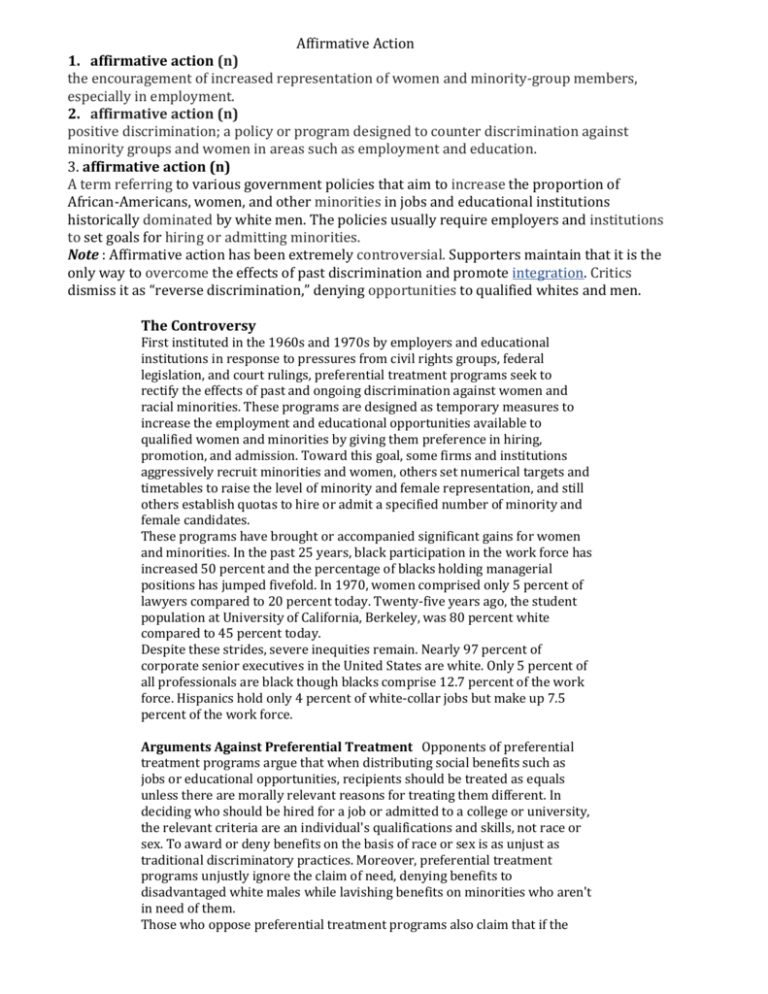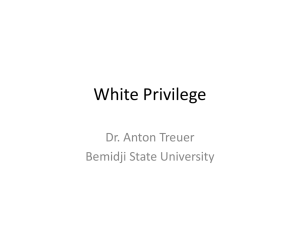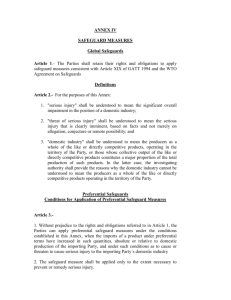Affirmative Action affirmative action (n) the encouragement of
advertisement

Affirmative Action 1. affirmative action (n) the encouragement of increased representation of women and minority-group members, especially in employment. 2. affirmative action (n) positive discrimination; a policy or program designed to counter discrimination against minority groups and women in areas such as employment and education. 3. affirmative action (n) A term referring to various government policies that aim to increase the proportion of African-Americans, women, and other minorities in jobs and educational institutions historically dominated by white men. The policies usually require employers and institutions to set goals for hiring or admitting minorities. Note : Affirmative action has been extremely controversial. Supporters maintain that it is the only way to overcome the effects of past discrimination and promote integration. Critics dismiss it as “reverse discrimination,” denying opportunities to qualified whites and men. The Controversy First instituted in the 1960s and 1970s by employers and educational institutions in response to pressures from civil rights groups, federal legislation, and court rulings, preferential treatment programs seek to rectify the effects of past and ongoing discrimination against women and racial minorities. These programs are designed as temporary measures to increase the employment and educational opportunities available to qualified women and minorities by giving them preference in hiring, promotion, and admission. Toward this goal, some firms and institutions aggressively recruit minorities and women, others set numerical targets and timetables to raise the level of minority and female representation, and still others establish quotas to hire or admit a specified number of minority and female candidates. These programs have brought or accompanied significant gains for women and minorities. In the past 25 years, black participation in the work force has increased 50 percent and the percentage of blacks holding managerial positions has jumped fivefold. In 1970, women comprised only 5 percent of lawyers compared to 20 percent today. Twenty-five years ago, the student population at University of California, Berkeley, was 80 percent white compared to 45 percent today. Despite these strides, severe inequities remain. Nearly 97 percent of corporate senior executives in the United States are white. Only 5 percent of all professionals are black though blacks comprise 12.7 percent of the work force. Hispanics hold only 4 percent of white-collar jobs but make up 7.5 percent of the work force. Arguments Against Preferential Treatment Opponents of preferential treatment programs argue that when distributing social benefits such as jobs or educational opportunities, recipients should be treated as equals unless there are morally relevant reasons for treating them different. In deciding who should be hired for a job or admitted to a college or university, the relevant criteria are an individual's qualifications and skills, not race or sex. To award or deny benefits on the basis of race or sex is as unjust as traditional discriminatory practices. Moreover, preferential treatment programs unjustly ignore the claim of need, denying benefits to disadvantaged white males while lavishing benefits on minorities who aren't in need of them. Those who oppose preferential treatment programs also claim that if the purpose of the programs is to compensate for past discrimination or present disadvantages, then only persons who have been discriminated against should be given preference. Current preferential treatment programs, however, favor members of selected groups regardless of whether an individual member has ever suffered discrimination. In fact, most of the victims of past discrimination are no longer living, so the issue of just compensation is moot. Critics of preferential policies further argue that society's burdens ought to be distributed fairly among its members. Preferential treatment programs are unfair because they impose the burden of compensation on white males who seek jobs or higher education. These individuals are no more responsible for past injustices or for rectifying present inequalities than any other individuals. It is unfair that they should bear the full burden of compensation. Programs awarding preference according to race or sex are also opposed on the grounds that they cause much more harm than good. First, with these programs in force, those who may be more qualified are overlooked while others only minimally qualified are chosen. The inevitable result is reduced productivity and efficiency in the work place and the lowering of academic standards in colleges and universities. In Defense of Preferential Treatment Preferential treatment programs are often defended on the grounds of distributive justice, which requires that society's benefits and burdens be distributed equitably among its members. As a result of past discrimination, women and minorities have been denied their fair share of opportunities. Entrenched and subtle discriminatory policies and practices continue to permeate businesses and educational institutions, ranging from prejudice in job classification and minority systems to biases in college entrance exams. A recent study of 94 Fortune 1000 companies revealed that only 2.6 percent of the surveyed firms' executives were minorities and only 6.6 percent were women. In 1988, the wages of women working in full-time jobs were 72 percent those of men. That same year the unemployment rate for blacks was 11.7 percent compared to 4.7 percent for whites. Preferential treatment programs seek to reduce these disparities as justice requires. Those who support preferential policies also appeal to the principle of compensatory justice, which states that people who have been treated unjustly ought to be compensated. Throughout history, race and sex have been used to deny individuals equal treatment in employment and education. And while many of today's minorities and women may not have been themselves the victims of discrimination, they have been victimized by its effects. As descendants of those who were denied jobs or relegated to low-paying positions, they have grown up deprived of the resources, opportunities, and education necessary to develop the skills and confidence needed to compete on equal terms with white males. Preferential treatment programs compensate for past harms and present disadvantages by giving qualified members of these groups preference in hiring or college admissions. Supporters of preferential treatment policies counter the charge that preferential treatment is as unjust as past discrimination. Past practices, fueled by ignorance, contempt, and hatred, systematically relegated minorities and women to inferior positions in society, while concentrating power and wealth in the hands of white males. Preferential treatment programs, in contrast, are not motivated by contempt for non-minorities and aim to achieve equal opportunity and provide a more equitable distribution of social and economic benefits.








